See Also: Kursi Excavation Project
By Charles R. Page, II
Jerusalem Institute for Biblical Exploration
December 2003
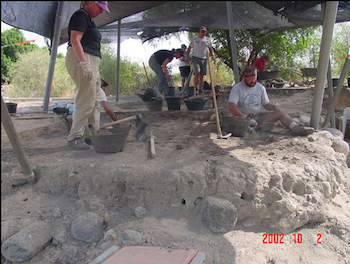
from an easterly spring.
The Kursi Excavation team returned to the field to begin its second season September 30, 2002. The excavation is under the direction of Dr. Vassilios Tzaferis of the Israel Antiquities Authority and Dr. Charles Page of the Jerusalem Center for Biblical Studies. Continuing from the previous season, Charles Page supervised the fieldwork in Area C and Pinhas Porat supervised the fieldwork in Area D. They were assisted by Karl Reed and Dr. Paul McCracken, both from the Jerusalem Center for Biblical Studies. Our transportation coordinator was Zaki Sayyad from the Mt. Of Olives in Jerusalem.
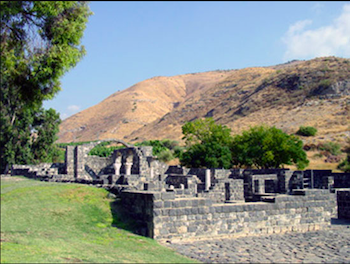
discovered in the center of the
largest monastery complex in
Palestine.
With the close of the 2001 season, we had discovered a well-preserved hot bath (caldarium) in Area C, northwest of the basilica. In Locus 18, we began to open into a second room of a possible bath complex to the north of the caldarium. We decided at that time (September 2001) that we would follow this direction in 2002.
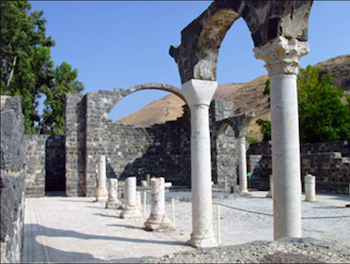
After our on site orientation and cleaning of the area, we laid out our squares and proceeded with the excavation. In Area D, we continued to probe a subterranean chamber. In 2001, we were able to descend 2.4 meters to the surface of the room. In 2002, we identified two additional rooms, and we removed the fill from all of them. We were disappointed that we could not find doors that might have connected these rooms with other areas. These rooms seemed to have functioned as one-time monumental usage. In the end, we closed the area and refilled the square.
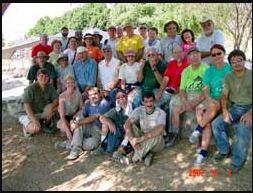
Studies 2002 Excavation Team.
In Area C, we opened two new squares north of the caldarium. We worked in vain for the first week. We did not find any walls, and I was beginning to think we were excavating in the wrong place. Originally, I had thought to open two squares to the north and two to the east of the caldarium. But I decided that we should follow the opening from locus 18. By the middle of the second week, we found walls with a well-plastered pipe and, eventually, a small pool which is part of a cold bath (frigidarium). By the end of the second week, we had completely excavated the entire frigidarium. In the room, we found a beautiful marble floor, a pool with a bench inside for sitting and soaking feet and legs, and a bench around the northern and eastern wall. There was no evidence of a tepidarium (warm bath).
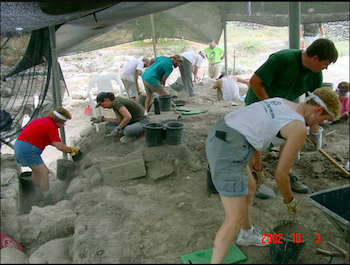
residential area.
During the last week of our 24-day excavation, we opened two new squares to the north of the frigidarium. We were able to lower the squares some 77 cm (about two and a half feet). During the week, we exposed several walls and flooring. In 2003, we will continue here and open addition squares to the north and east.
CONCLUSIONS
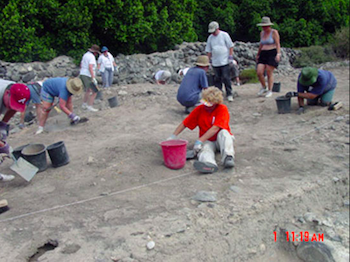
clearing North of the
bath-complex on Oct. 1,
2003.
During the first season (2001), we were surprised to find the bath (caldarium). Our principal question was why was this here? Finding such a bath complex in a monastic setting was unheard of. Yet, here it was. Thus far, we have concluded that this bath must somehow be connected to early Christian pilgrimage. The site was sacred to early Western Christians. In subsequent years, we may find a full bath with a frigidarium, tepidarium, and apodarium (changing room), and, perhaps, a pilgrimage hostel of some kind.
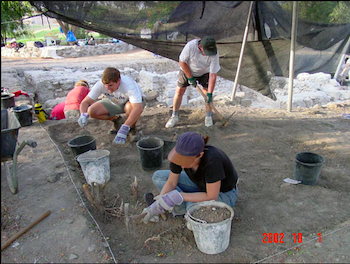
Shoshi work on an eastern balk in area C.
After the 2002 season, we began to think of other possibilities. Perhaps there was a small Christian community located within the walls of the monastic compound. If so, then the completed bath might have been used by the people of this community. Perhaps we have a combination of a local community and pilgrim center.
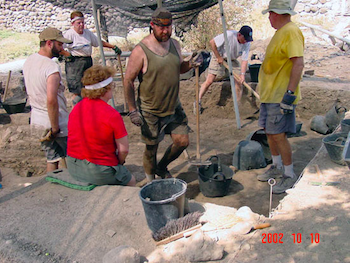
During the excavations, we found Persian swords, spear points, knives, and a scythe (used for executions) in the bath. We also found coins, lamps, many sherds from jars and pots, rings, and pieces of jewelry. A number of very rare and unique pieces came to light after cleaning, especially an extraordinary ring with the image of Jesus on it as well as one of the best preserved sixth-century Byzantine coins.
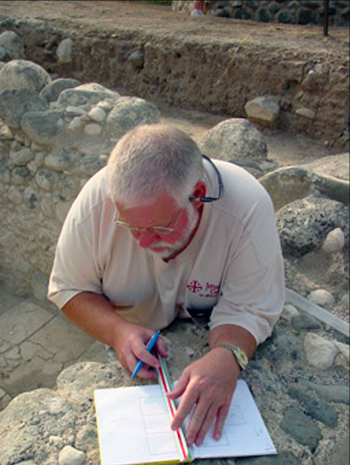
location in relation to the bath-complex.
We know that the Persians destroyed this complex (church, monastery, and community) in 614. Here we found the first physical evidence of the Persian assault. This seems to be the first Christian community conquered and destroyed by the invading Persians. In 620, the Christians returned and reclaimed the property. In 636, the Ummayads had assumed control of Kursi, but they allowed the Christian community to continue to worship and live according to their beliefs and traditions. Kursi was destroyed and abandoned following the great earthquake of January 18, 749 CE.
